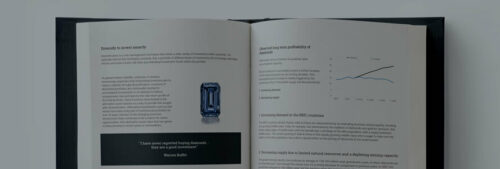Diamonds are an excellent investment for several compelling reasons. The fundamental economic principle of supply and demand suggests a long term oriented increase in diamond prices on the global market. The stability of diamond prices, which are typically affected only by significant events, has repeatedly showcased their resilience. The rapidly evolving diamond industry presents new opportunities, making now an ideal time to diversify your portfolio with natural diamonds. Our expertise highlights the key reasons why investing in diamonds is a valuable addition to your investment strategy.

Why invest in natural diamonds?
Stable value on long term
Natural diamonds are proven to be one of the most crisis resistant investments when compared to the volatility of other types of investments or commodities. Where traditional investment portfolios, including shares, bonds, property and futures contracts crashed during previous financial crises, polished diamonds saw only a little downturn. Therefor BNT sees a significant growth in the demand of investment diamonds which is often seen in times of crisis, instability and global insecurity.
And if you look at the price over a 100-year period, you will notice a long-term steady price increase. Of course the diamond value can fluctuate on short notice (from week to week or month to month), but over a long period of time diamond tends to keep the underlying value and, in many cases, see even positive rates of return. This is influenced by the limited natural resources and ever depleting supply.
Supply is declining
The supply of natural diamonds is becoming increasingly scarce, particularly for higher qualities (the investment category).
This is influenced by a few factors:
- No major new mines are in the pipeline. And minimal investment has been made in exploration for new mines over 25 years. Fewer and fewer new diamond mines are found, certainly not any large ones. For example, companies are searching locations in Canada today, where depending on the weather, they can only drive over the ice one month a year.
- It takes more and more effort to extract the products, as with oil. This led to the closure of older mines, like the well-known Australian based Argyle mine (closed in 2020). Mining companies have to dig deeper and deeper to unearth new diamonds. To the point where operating the mine is no longer profitable, and the mine is closed.
- Natural diamond is a limited natural resource that will be ‘depleted’ at one day.
Certainty for more than a century
With a scarce product that will one day be ‘depleted’, at least without immediate changes in sight, the future of natural diamonds looks positive. That has been the case for the past hundreds of years. The price curve has always shown a soft, stable increase during this time frame. With relatively shallow dips and rarely some peaks upwards. This is in contrast to the price curve of gold, for example.
Demand increases
The price of diamonds depends almost exclusively on the game of supply and demand. And although demand sometimes fluctuates in the short term, it continues to rise in the long term. According to specialists at the American consultancy company Bain & Company, the demand for natural, rough diamonds will continue to increase up to 2% annually until 2030, due to strong U.S. foundations and the growing middle class in China and Japan.
Can a changed policy affect the demand? We saw this fleetingly in China in 2016, when the government curtailed the purchase of luxury items. But in the end, the impact on demand proved small and short-lived.
Selective liquidity
Despite the absence of a public trading platform, diamonds remain highly liquid assets, though this liquidity varies across market segments, requiring tailored approaches. Generally, there are two categories: Commercial grade and Very rare diamonds.
Commercial Grade Diamonds:
These diamonds, despite their rarity, have widespread demand. Popular for investment are colourless, high-quality round diamonds between 1 and 3 carats, with at least a G color and VS2 clarity, certified by GIA, HRD, or IGI. This segment is active due to its common use in jewelry, allowing for profitable resale if purchased wisely.
Very Rare Diamonds:
These unique diamonds appeal to a niche collector's market, driven by speculation. They include very large, intensely colored, or exceptionally well-cut fancy-shaped stones. Reselling such diamonds, often through auctions, is complex and requires expert guidance. Despite this, their value has significantly increased, attracting investor attention, particularly towards colored diamonds.
Additional benefits: compactness and emotional value
Compactness
A diamond is light, its transportable anywhere and anonymous. With just a few small diamonds, you are carrying a lot of wealth. That advantage is all the more evident in politically unstable countries.
In addition, you can start investing already from a budget of € 5,000.
Emotional value
The financial value of jewellery and natural diamonds is very important, especially when they are being purchased as an investment. But they are also timeless and durable.
These are precious objects that are purchased or given as gifts for special occasions. They are passed on to future generations carrying along with them the stories of the people that wore them, adding emotional value to even the simplest piece of jewellery. Precious pieces of jewellery can be passed on through generations as heritage and remain intact, they often become the last piece that reminds you of that one person or that one special occasion.

All investors are advised to fully understand all risks associated with the investment. All investments involve risks, and each investment decision remains the responsibility of the decision-maker. There is no guarantee that your investment will be profitable, or that it will not be generating a loss.
More information on supply and demand trends

